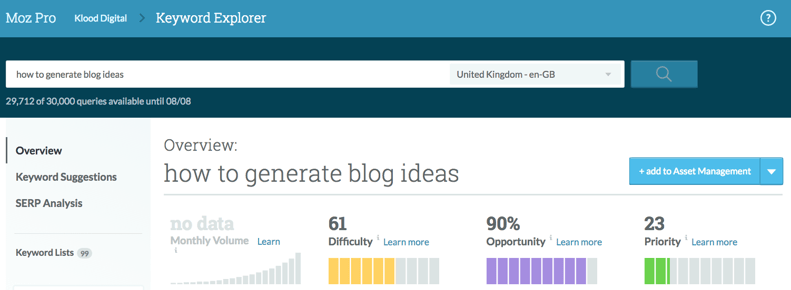
Get weekly
HubSpot updates
We are all aware of how important it is to create fantastic and unique content, but actually coming up with the ideas for that content is a big challenge in itself.
In this post I’m going to share some learnings and summarise how I approach coming up with a blog topic for business marketing.
First and foremost - relevancy
Your blog post content has to be relevant to your buyer personas — fictional representations of your ideal customer. We typically have three personas in mind at SpotDev: ‘CEO Charles’, ‘Marketing Mary’ and ‘Sales Simon’. These have been created based on our client’s typical needs and how our services help to resolve their issues.
READ MORE: Buyer Personas - What are they, why you need them and how to create them
Before writing this blog, I made sure I had a good look at our persona’s needs and concerns. Content marketing is very relevant to our ‘Marketing Mary’ as she is responsible for getting visitors to the company website, converting visitors to leads, and turning leads into customers.
Blogging (as part of an inbound marketing strategy) is a relevant topic for her — she doesn’t have a lot of time as she is stretched across a lot of marketing tasks. Therefore hints, tips and practical content creation advice should be useful and (hopefully!?) well received.
With this in mind, I've come up with ten tips for coming up with killer content ideas.
Tip #1: Read your buyer personas as your first action.

Actually coming up with your blog’s content can be a daunting prospect — how and where do you start? My favourite description about where ideas come from is by David Lynch. He describes ideas as ‘being like fish’ and that ‘if you want to catch the big fish, you’ve got to go deeper’.
You don’t make a fish. You catch a fish. A lot of artists, inventors and creative folk will tell you the same thing — that an idea somehow already exists in some form, what you need to do is to pull it together. Or as Lynch says, ‘catch’ the idea.
I like to think of it as forming the right question in your mind, then letting the answer unfurl.
Tip #2: Have a question in mind. Then forget about it.
Where do you have your best ideas?
Before reading on, please think about this for a moment… seriously, where do you have your best and brightest ideas?
I bet that none of you thought: ‘I have my best ideas at my desk’. I suspect you have your best ideas when ‘walking the dog’, ‘driving to work’, ‘in the shower’, ‘listening to music’ or similar.
There is a scientific reason for this.
Alpha waves are typically present when the brain is in idling state. Alpha waves spontaneously support daydreaming and creative thinking. When you’re at your desk, you’re geared for analytical and cognitive thinking. Great if you’re working with spreadsheets, less ideal when you’re wanting some creative spark.
Tip #3: Give yourself a break.
First and foremost, stop ‘trying’ to think of an idea. For this blog, I formed three questions in my mind: ‘how do I explain idea generation?’, ‘how do I relate this to inbound marketing?’, and ‘how do I make this practical?’.
I didn’t actively think about these questions — I put them to the back of my mind. Over the next few days, ideas simply came to me when I was not looking for them: when I took a lunch-time stroll, when I was listening to Katy Perry, and when I was reading a book whilst waiting for my daughter to finish dance class.
If you’ve not tried this approach before then you may be a little skeptical. If you’re going to give this method a try then you must do the following...
Tip #4: Write down an idea as soon as it comes to you: wherever and whenever.
You might think you’ll remember all your ideas; but you simply won’t. A lot of good ideas get lost this way.
I know a few people who carry around a small note-book for this very reason — this is their ideas book. For me, I prefer to dump any ideas I have into a Google Doc — something electronic so that I can copy and paste and flesh out the ideas in the same place I’ve first listed them.
When you have your idea don’t judge it. Just write it down. At this stage it is neither good nor bad. An idea that you later reflect upon as a ‘bad’ idea may in turn trigger a good idea. Just write it down for now.
Some people like to brainstorm with others, while some like to work on their own. Either is fine — go with what you are most comfortable with. For this blog, I worked on this on my own knowing that I’d get some good constructive feedback from our marketing team when they reviewed the first draft.
I waited until I had about twelve content ideas in a Google Doc. Then, I looked at them and reviewed which ones I felt should be in and which ones should be out. You can pretty much work out what made the cut by the tip numbers!
A collective brainstorm
If you’re holding a collective brainstorm then try to encourage people to come along with thoughts already in mind (give them notice — don’t spring a brainstorm on people). Ban the phrase ‘yes, but’. Replace ‘yes, but’ with ‘what if’.
Do this away from your desk. Go somewhere you are comfortable and relaxed; this is the reason why agencies have ‘funky’ environments — they are spaces for intuition and creativity.
Tip #5: Trust your gut instinct.
Whether you’ve worked alone, or as a team, review all of your content ideas. You’ll be drawn to some and you’ll realise that some aren’t for now. Trust your gut instinct. Out of these you should hopefully have three or more content detail ideas that look like they could work.A clear piece of writing should have one clear idea - the main topic of this blog post is ‘how to generate ideas for content marketing’. It is however comprised of several ‘sub-ideas’ that I’d jotted down during my ideation process. When you’re reviewing your list of ideas, group similar topics together - decide which ones are a blog in their own right and which ones will combine well together into an over-arching idea.
Validate your ideas
Before starting to write you need to have evidence that there is an audience who will be interested in your content. You should already be certain that your content is relevant to your personas.
Tip #6: Undertake keyword research: finalise your blog title.
The next step is to do some keyword research. Check out this blog for help — The Best 5 Tools for Keyword Research.
I used Moz for my keyword research. My draft blog title was ‘Good Blog Topics — How to Generate Ideas’. The keyword research I conducted suggested some more popular alternate search phrases. My blog post then became: ‘How to Write a Blog — Ideas for Content Marketing’.

What have competitors/ others done?
Moz also provides SERPs (Search Engine Results Pages) analysis. You can use the SERPs analysis to review the blog posts currently ranking well for the title and content you have in mind. For this blog, this step helped out in several ways:
- Confirmed that what I had in mind matched with what readers are consuming.
- Confirmed that my content is in line with industry thinking and best practice.
- Provided some storytelling inspiration and writing reminders.
- Encouraged me that, by giving this blog a personal storytelling slant, I’d create a different angle to a lot of the existing similar popular blog content.
- Confirmed that I must stay practical - I must offer clearly discernable and applicable tips.
If you have specific competitors then you may also want to review their sites to see if they have created similar posts. You’re looking for information that will help to inform your own writing. If they have created similar, how can you make your blog better and / or more relevant to your personas?
Tip #7: Get evidence that readers will be interested in your content.

I also had a very quick look at BuzzSumo. By now, I was fairly comfortable I had outline content ideas and evidence that this blog ‘should’ be of interest to SpotDev’s target audience. However, if you’re perhaps still unsure, then Buzzsumo is another tool into which you can input your content ideas. It will enable you to review and harvest existing content — informing your own content idea generation.
One final thing to check...
Tip #8: Get the thumbs up from your marketing colleagues.
Does this topic link in with your other marketing activity?
Before writing this blog I had a look back at SpotDev posts on similar topics and at our active marketing campaigns (our eBooks and landing pages in particular).
Sure, I’d like you to simply read and enjoy this blog, but I am honest enough to admit that what I’d really like is to convince you to switch from being an unknown visitor into a lead. I know I need to offer you something of value in return for your contact details. For this reason, one of the very first pieces of content I put into my blog draft is the call-to-action that you can see at the end of this post.
Ready to start writing? Are you the right author?
You should now be ready to start writing.
You have a topic in mind, you have multiple content ideas that you can flesh out into a blog and you have evidence that there is interest in this topic.
However, there is one more question you must ask yourself — is this a topic you can write about authentically?
I’ve spent the better part of twenty years working agency-side on digital marketing campaigns and creative projects. I’ve learned a lot (by both failing and succeeding) and I feel comfortable that I have authentic stories and tips to share on coming up with ideas and how to create great content.
Be honest with yourself: if the content topic you have settled on is a long way outside your sweet-spot (and you have someone in your team better qualified to write about it) then go and seek their support.
Tip #9: Get the most authentic member of your team to write the post.
If your colleague is uncomfortable writing a full article, then you can ask them to provide an outline, or bullet points, that you or a copywriter can finalise.
What will you learn?
Once your blog is live, seed it in all the places you have a natural and authentic connection. This blog will be posted on our website and shared on LinkedIn, Facebook and Twitter. We’ll potentially also include a link in our email marketing — if it’s relevant to that month’s theme.
When they feel the content is relevant to their connections, our team will also personally share SpotDev’s social posts. Don’t force a sharing — if it’s not relevant with your peers then they don’t want to see it! Be credible.
Once the blog is live, look at the traffic it’s generating and where it’s coming from. Comments from readers are incredibly useful. Don’t stress if you get any negative comments - everyone is entitled to their own viewpoint. Learn from errors as well as from successes.
Tip #10: There is no such thing as failure, only feedback.
Before you write your next blog post, what does your experience of this one tell you? What will you do differently next time? Write this down so you don’t forget!

